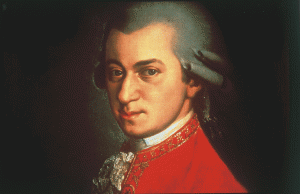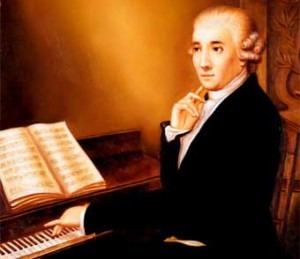
credit : http://virtualmusiccomposer.wordpress.com/
Mozart’s early experience with Italian opera is documented in Daines Barrington’s report to the Royal Society in London, published in 1769. “At nine, the prodigy could already, in improvised recitatives and arias, ape operatic styles suited to anger and tenderness”. Clearly, Barrington’s assessment was accurate as the eleven year old Wolfgang had written his first complete dramatic work Apollo et Hyacinthus already in 1767. Not surprisingly, it was written for the University of Salzburg, which had a tradition going back to 1617 of hosting an annual theatrical play. In 1767 the play “Clementia Croesi” was written by the University professor and priest Rufinus Widl. As was customary, the Latin theatrical play was alternated by a musical interlude that provided a thematic link, and in most cases a secondary plot. Like “Clementia Croesi”, Apollo und Hyacinth is also based on a part from Ovid’s “Metamorphosis. The young and gorgeous boy Hyacinthus becomes the object of desire for both the god Apollo and Zephyrus, the West Wind. Apollo is teaching Hyacinthus how to throw the discus, while at the same time extracting sexual favors. Naturally, this enrages Zephyrus, who blows the discus back at the young boy and fatally wounds him. Unable to save Hyacinthus, Apollo transforms his body into the hyacinth flower. It’s not surprising that Rufinus Widl, who also wrote the Latin libretto, modified the story before engaging the young Mozart to write the music. Conforming to the social standards of his time and addressing his distinct distaste for homosexuality, Widl changed the desired character from the lad Hyacinthus to the lass Melia. Mozart’s musical setting, which unfolds in three acts, features elaborate arias and extensive recitatives, clearly takes its bearings from the Italian operatic culture that pervaded Austria and Germany. Adhering to the opera seria tradition, it also features the first-ever vocal trio composed by the young Mozart. Students and faculty first performed this miniature opera on 13 May 1767, at the Great Hall of Salzburg University.
Wolfgang Amadeus Mozart: Apollo et Hyacinthus
One year later, on 27 April 1768, Florian Reichssiegel provided the five-act tragedy “Pietas conlugalis in Sigismundo et Maria” for Salzburg’s Benedictine University. This time, Michael Haydn was engaged to provide the musical interlude and composed the Singspiel Die Hochzeit auf der Alm (The Wedding on the Alpine Pasture), linking with the play through the common theme of marital fidelity. Instead of using Baroque scenery, the stage was made up in the manner of an alpine hut. Featuring arias and duets characterized by folksy melodies, the singspiel also contains four instrumental movements. For Salzburg, and for the young Mozart, “The Wedding on the Alpine Pasture” was a pioneering work that not only enjoyed wide distribution within Austria, but also spurred the young Mozart to try his hands at a singspiel.
Michael Haydn: Die Hochzeit auf der Alm (The Wedding on the Alpine Pasture)
When the Viennese physician, magnetist and hypnotist Dr. Anton Mesmer commissioned Mozart to write a singspiel in 1768, the twelve-year old composer quickly responded in the manner of Michael Haydn. Mozart got a suitable libretto, essentially a satire of the prevalent pastoral genres, from the Salzburg court trumpeter Andreas Schachtner, who in turn relied on a German translation of Jean-Jacques Rousseau’s “Le Devin du village “ (The Village Soothsayer). Interspersing sung and spoken text, Bastien und Bastienne unfolds in a typical rural setting with a shepherd and shepherdess interacting with a magician. Supposedly, it was first performed in Mesmer’s garden, but the first documented performance of this comic opera was only given in Berlin, in October 1890. It is of course interesting that Mozart’s overture uses the same opening theme as Beethoven’s “Eroica” Symphony, which will be composed roughly 40 years later.
Wolfgang Amadeus Mozart: Bastien und Bastienne
The designation of musical works as “Divertimenti” generally refers to compositions intended for the enjoyment of the listeners and the players, serving unobtrusively as background music for social gatherings. Rather than engaging in a dramatic musical narrative or providing deep emotional contrasts, the Divertimento, alongside the Serenade, Cassation, Notturno, Nachtmusik, Tafelmusik etc., was expected to provide uncomplicated and unadulterated listening pleasure. Varying greatly in regard to the number of instruments and movements — ranging from a single to the occasional thirteen movements — the Divertimento and related musical forms enjoyed great popularity in the second half of the 18th century. Through Michael Haydn, Wolfi Mozart came into contact with the early Divertimeni settings of Franz Joseph Haydn. Not surprising, Mozart’s first symphonic experiments are dutifully classified as “Salzburg Divertimenti”.
Haydn, Franz Joseph: Divertimento in F major, Hob. II:20
Wolfgang Amadeus Mozart: Divertimento in F major, K. 138,
“Salzburg Symphony No. 3
Please join me again next time, when we accompany Mozart on his journey to London. There the young Mozart made the acquaintance of Johann Christian Bach, youngest son of Johann Sebastian Bach, who essentially dominated the musical scene with his concerto, orchestral and operatic compositions.


